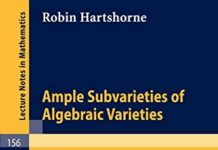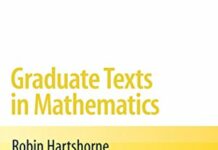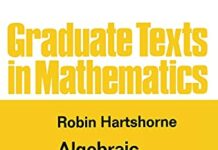
Ebook Info
- Published: 2000
- Number of pages: 540 pages
- Format: PDF
- File Size: 40.15 MB
- Authors: Robin Hartshorne
Description
This book offers a unique opportunity to understand the essence of one of the great thinkers of western civilization. A guided reading of Euclid’s Elements leads to a critical discussion and rigorous modern treatment of Euclid’s geometry and its more recent descendants, with complete proofs. Topics include the introduction of coordinates, the theory of area, history of the parallel postulate, the various non-Euclidean geometries, and the regular and semi-regular polyhedra.
User’s Reviews
Reviews from Amazon users which were colected at the time this book was published on the website:
⭐I will be using this product to research the foundations of elementary geometry.
⭐I really don’t have much more to say than has already been said. It’s an excellent book. Not too well suited to the conformist as many proofs of known results have originality. For the beginning parts of the text some reviewers advise to keep the Elements close by but the same propositions and proofs can be found with Google search. More critical to a good reading of this book is a knowledge of Galois theory. I found the book by Ian Stewart
⭐suggested by the author quite adequate for this (as well as an introduction to most ideas of modern algebra). Galois theory is key to many of the constructability and unsolvability results in the text. Dehn’s solution of Hilbert’s Third Problem is quite good as other reviewers have mentioned. The method of using an invariant is reminiscent of the methods of algebraic topology. Euclid uses a limiting process known as the method of exhaustion to show that two tetrahedra of equal base areas and equal altitudes have equal volumes. This process is akin to slicing the tetrahedron into thin slabs using parallel planes-similarity or homothety will give a functional form to the slabs and Riemann summation proceeds. The question is whether this process is needed or can the volume be found by dissection,i.e. broken up into parts whose volume is easily calculated or known and then summed without this limiting process. Can the tetrahedron essentially become a parallelepiped or equivalently a cube under this process? An abelian group is constructed from elements formed of the tensor product of an edge and its associated dihedral angle-strong influence of topologist Dehn. In the end the proof hinges on the dihedral angle of the regular tetrahedron and whether it is a rational multiple of Pi. It is not and this shows the Dehn invariant to be nonzero but the cube’s invariant is zero so dissection will go to this infinite limiting process. So the limiting process is necessary. The proof the author gives for the dihedral angle is elementary if you aren’t up to speed with Galois and a second proof is given with Galois theory which will seem easier for those skilled here.
⭐The book begins with a quotation from Gauss that suggests the elegance of treating Geometry in the “pure spirit of geometry” i.e. without using real numbers. And Hartshorne follows this principle by developing Euclidean geometry at first from the Elements of Euclid and then (after remarking their weaknesses) by using Hilbert’s axioms. However the book is not about the foundations of geometry and much attention is given to the meaning of these axioms in the context of ruler and compass constructions and how this topic is related to analytical methods which lead directly to the theory of field extensions and Galois groups.I think one of the main purposes of this book is to show how the abstract structure of a Field arise naturally both in Euclidean and Non-euclidean geometry and in this way prove that their typical algebraic models are categorical (that is, they are unique up to isomorphism) which is interesting for its own sake.So this is not the usual approach to Geometry based on groups of transformations which can be found on other books, but a more “classical” one. But even if the approach is classical, the study of classical problems is always connected with modern algebraic facts, the most striking of them (for me) is the use of algebraic invariants to solve Hilbert’s third problem which can be perfectly formulated (but not solved) in elementary terms.
⭐Hartshorne is a famous algebraist and one main contribution of this text is to show fascinating interrelations between classical geometries and modern algebra (of course the book contains lots of pure geometry as well). Example 1: Many texts show the impossibility of the classical problems of constructibility by straightedge and compass (by observing that the coordinates of any point so constructed lie in the smallest extension field of the rationals Q closed under taking square roots of positive numbers). Hartshorne’s is the only text that goes further, solving the analogous problem when the straightedge is marked (real roots of cubic and quartic equations must also be allowed); Archimedes observed that any angle can be trisected with these tools. Example 2. Dehn’s solution to Hilbert’s Third Problem is given, whereby any two polyhedra equivalent under dissection must have equal Dehn invariants, and it shown that a tetrahedron has different invariant than a cube. Example 3. In hyperbolic geometry, Hilbert’s arithmetic of ends is developed and applied. Example 4. Pejas’ algebraic classification of Hilbert planes is discussed. Hartshorne’s text overlaps mine in correcting Euclid’s errors, developing rigorous foundations for Euclidean and Non-Euclidean geometries, and covering much history, presented delightfully. He gives a thorough discussion of area and the open problems in that theory. He concludes with a nice chapter on polyhedra.
⭐Informative, 4/5.
⭐Hartshorne’s ‘Geometry’ is excellent. Sadly the new copy I received is, like increasingly many Springer titles, a print on demand copy which has been reproduced from page scans. While perfectly legible, the text is ragged, and overall the copy feels cheap, which does this classic text rather a disservice.
Keywords
Free Download Geometry: Euclid and Beyond (Undergraduate Texts in Mathematics) in PDF format
Geometry: Euclid and Beyond (Undergraduate Texts in Mathematics) PDF Free Download
Download Geometry: Euclid and Beyond (Undergraduate Texts in Mathematics) 2000 PDF Free
Geometry: Euclid and Beyond (Undergraduate Texts in Mathematics) 2000 PDF Free Download
Download Geometry: Euclid and Beyond (Undergraduate Texts in Mathematics) PDF
Free Download Ebook Geometry: Euclid and Beyond (Undergraduate Texts in Mathematics)



